Part 1: My Journey to Quilting
My love for quilting is knowing I can do what I like and that I am free to make my own rules. I have always loved fabrics, especially the beautiful colors, prints and textures of the material. I really enjoy using bright colors with a lot of negative space in the background. In some of my work, there is a heavy use of black because I enjoy the contrast between bright and dark, but it also represents the depression I manage. Quilting keeps me grounded and creative. Through my art, I found a way to turn this darkness into something positive. The joy I get from quilting also carried me through the uncertainties of the pandemic. It allowed me to contribute to my community in a time of need and to turn my attention to creating beautiful things from recycled fabric.
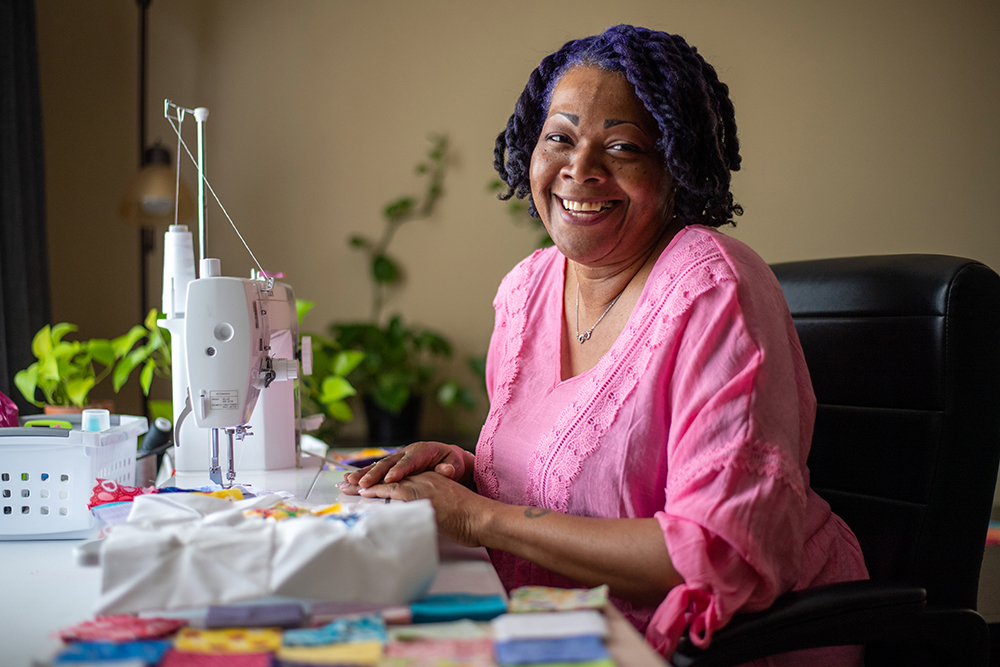
Above (main image): These 3” quilt squares are called “charm squares” that Janice uses to create new projects and teach people how to quilt.
Right: Janice Mitchell at her workstation.
All photos by Rory Doyle, courtesy of the Mississippi Arts Commission
I started quilting over twenty years ago. I taught myself how to quilt by looking at pictures and replicating the patterns in my favorite books. 1 From the moment I created my first quilt top, I knew this was something I would one day do full-time. My first projects focused on learning piecing skills. “Piecing” is a common term in quilting, and it means to sew small units of fabric together by hand or machine to construct a larger work, like a quilt of any size. In my early projects, the pieces of fabric that I used were two-and-a-half inch squares that made it easy to fabricate miniature block pattern quilts. When I first started quilting, I pieced and stitched my quilts completely by hand and now I make quilts from a combination of hand and machine quilting. These projects were a fun way to learn the craft, test out color combinations, and be frugal at the same time.
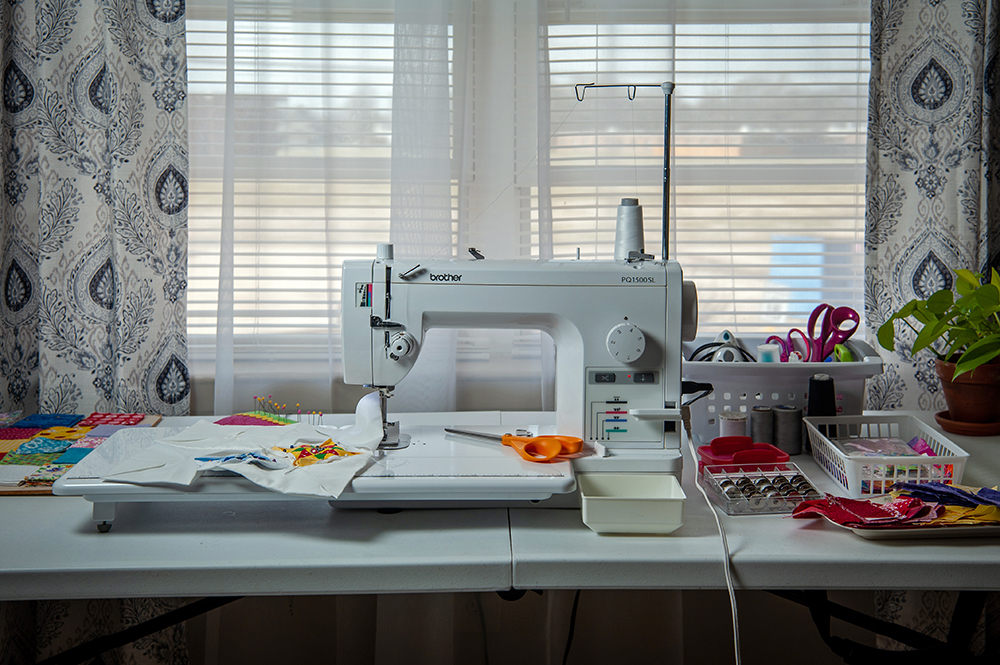
Left: Janice’s sewing machine and workstation at her home
Through these years of teaching and encouraging young people to be creative,
I realized that being a
quilting teacher
is my joy.
My process of quilting starts with two squares of fabric no matter how large or complex the finished product will be. When I decide on a comfortable size to cut the squares, I sew them together in an assembly line fashion. This approach helps to speed the process along. After I have a sufficient amount of squares sewn together, I will move over to my ironing board to press the seams open. Sometimes, I talk family and friends into assisting me. For example, when my son still lived at home, he was a tremendous help to me. He always helped clip loose threads and trim little corners from pieced blocks. Several times he showed interest in my design process and gave me great ideas. I would let him choose the pattern layout by simply placing the squares where he liked. I taught him how to piece on the sewing machine, design quilt patterns on grid paper with coloring pencils, and hand quilt at age nine. He is 33 years old now, and he is currently teaching his daughter to quilt using the techniques I taught him. Teaching my son was exciting, and seeing his development in quilting made me want to share the craft with anyone who wanted to learn. At the same time I was teaching my son, I started showing young children in my community how to sew. I love seeing people light up with happiness when they see what they can create. Through these years of teaching and encouraging young people to be creative, I realized that being a quilting teacher is my joy.
My plans to quilt full time and teach were coming together and all looked great for Spring 2020. I was building up my supplies and equipment to begin teaching people in my home. I felt excited and that nothing was going to stop me, but the television news reports started coming in as alerts. The message was very ominous. I tried to make sense of what I was seeing and hearing. This virus was deadly, swift and spreading, but we all thought “something” would happen to contain it so we could get back to some sense of routine and structure. However, that was not the case. I woke up to phone calls about getting food and supplies. A letter was placed on my door notifying me of a “Shelter In Place Order” issued by the governor of Mississippi. My anxiety was heightened. I felt terrified and truly alone; my family lived out of state.
It was good to experience people coming together to help one another especially when the demand was incredible.
Part 2: Mask-Making During the Pandemic
During the first few weeks of quarantine, I thought I should create the quilts I had always wanted but seemed to not have time for. I was feeling overwhelmed by the news and uncertainty, and it was very isolating to be in quarantine alone. I limited the number of hours I watched television and focused on sewing and quilting. Each day the reports were full of fatalities, shortages and other disasters, so I grounded myself by acknowledging all the positive things happening. The sun still rose, the birds still sang (including my parakeets, Pickles and Cupcakes), and my granddaughter Bella Grace kept me going.
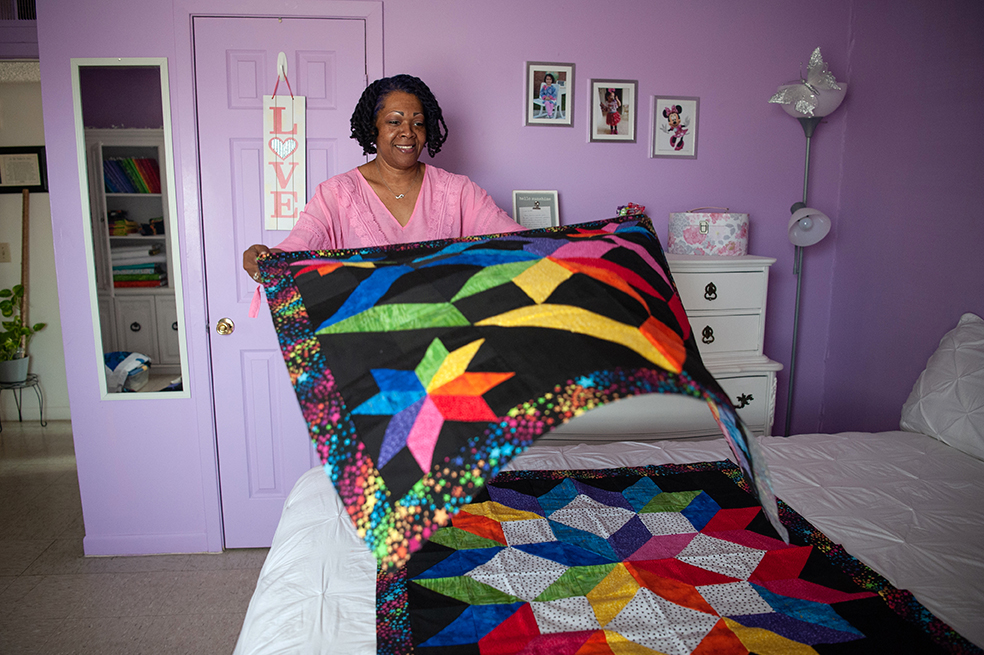
Right: After making her first Rainbow Star Quilt, Janice made a series of rainbow star quilt tops. In this photo, she displays a couple of quilt tops from her Rainbow Star series that she made during the pandemic.
The first thing I observed during quarantine was how people drew closer together and helped in whatever ways they could. I felt tremendous comfort in this and reciprocated. I chose to focus on what I could do or contribute. Masks were needed for the public. I saw a local news interview on Greenwood, MS artist, Yolande Van Heerden, who was making face masks, and she provided the pattern on Facebook. Her studio is wonderfully colorful and I thought, “Here is a kindred spirit helping. I will also pay it forward.” I used her pattern and made masks in batches
The first masks I made were a replica of a surgical or disposable mask with three layers. I used fabrics I had for quilt projects to make the decorative outside layer of the masks. I also purchased 100% flat cotton sheets to provide a filter for the middle layer as well as the backing of the mask that directly covers the wearer’s face. The sheets were a resourceful alternative to costly fabric that was quickly selling out. The pandemic caused shipping delays and restrictions from some of the fabric suppliers I had from other countries, so every piece of fabric became a precious commodity to me.
As I looked at the piles of scraps I was accumulating from mask making, I knew I would not waste them.
When I tried to make the N95 masks, I needed elastic. I tried to order some online, but most of the sources I went to were out of stock. I tried Walmart several times and had no luck finding elastic there, but I was not alone either. Many women were there looking for fabric and elastic too. It was good to experience people coming together to help one another especially when the demand was incredible. During my trips to the store, I learned from other sewers that hair ties would work as a substitute for elastic. In the aisles, we shared sewing tips and passed along information between mask makers, as well as which sources were available to buy materials. I also took full advantage of YouTube and Google. I watched many videos that offered the steps I needed. I even found a tutorial where I learned how to “batch” sew masks, which means to sew in increments of ten. I cut fabric, linings and filters in one session. Next, I stacked my layers together in quantities of ten per batch. For the following step, I sewed seams one after another until I completed my specific batch for the day. I determined how many masks I could make by the amount of fabric I had. It was a very efficient method.
During this time, I was able to donate about 600 masks throughout several counties.
Making the masks was therapeutic, and helping in any capacity lifted my spirit as I felt that I could be proactive instead of reacting with fear. As the pandemic dragged on, I continued to make masks, check on those close to me, and work on projects I had set aside. As I looked at the piles of scraps I was accumulating from mask making, I knew I would not waste them. I saved excess cuttings as did most people I knew who sewed. People also donated their leftover fabrics to me because they knew I love to sew. This was an added bonus, something else to be grateful for in a turbulent time.
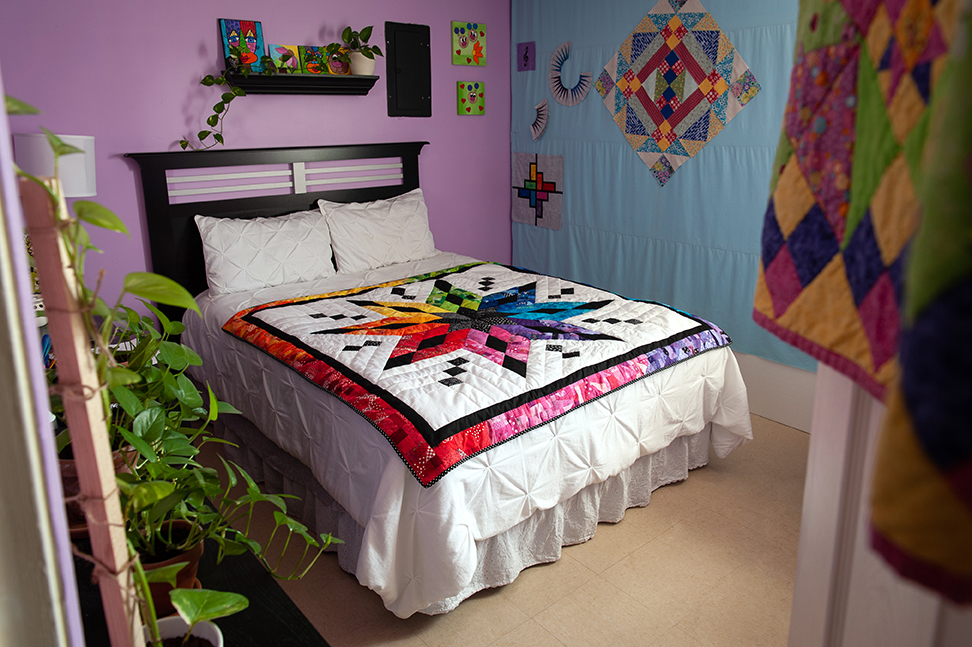
Left: Janice’s Rainbow Star Quilt on display in her guest bedroom. Janice created a blue felt wall (far right) in this room to lay out and plan her quilt projects. A few projects that she is currently working on can be seen on the felt wall.
Part 3: The Rainbow Star Quilt
After making so many masks, I had built up a substantial collection of leftover fabric. While sorting through one of my many piles of excess fabric, I decided to use the mask scraps to make a quilt project instead of buying more material. I settled on a lonestar pattern because it is my favorite quilting pattern, and the star symbolizes hope and happiness to me. Making the Rainbow Star Quilt allowed me to focus on an uplifting endeavor that gave me an escape from the news and reminded me that we still have things to be grateful for.
I wanted to create a star that was bright and colorful. I was inspired to use the colors of the rainbow, a happy symbol and one that is very comforting to me as it reminds me of God’s love. To begin, I sorted the scraps by the colors pink, red, orange, yellow, green, blue, indigo, and violet. I then sewed the small scraps of fabric together to form panels in each color group. I created the panels through a technique called “crumb” piecing, which is sewing together random pieces of tiny fabric with no specific size or measurement. These panels became the blocks that I would use to build my star and the border of the quilt.
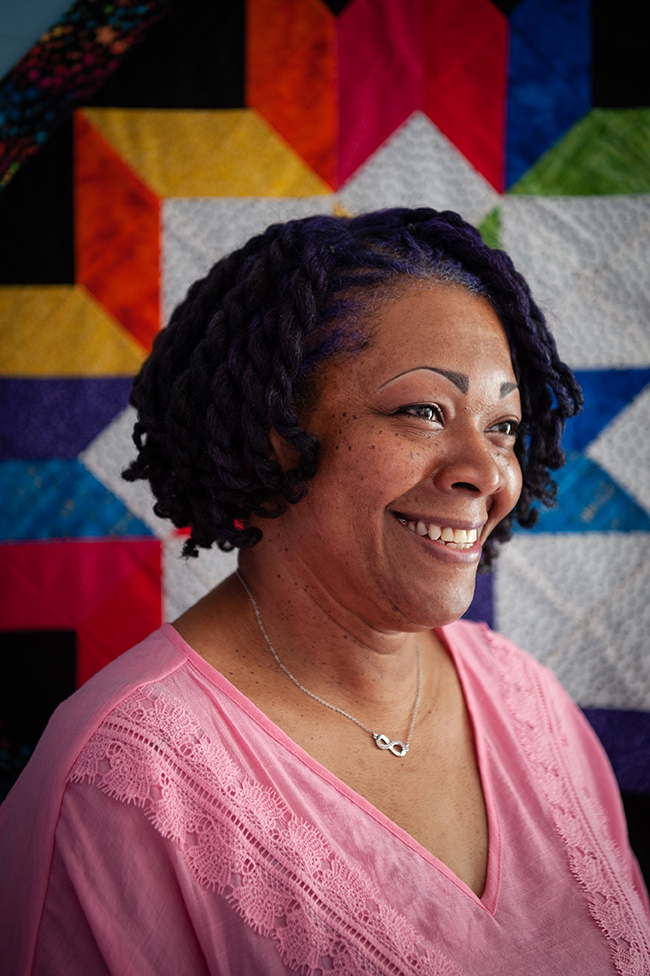
Right: Janice Mitchell in front of one of her rainbow quilt tops
I also needed some white and black fabric in my design. Like the rainbow scraps, I sourced the white and black blocks from my excess fabric collection. The white sheets that I used to make the mask filters and backing provided me with the perfect material to create the background surrounding the star. The black fabric was leftover from projects that I was working on right before the pandemic began.
I machine pieced the panels according to my pattern, and when I finished the quilt top, I added the batting to stuff the quilt. I kept the back of the quilt simple and opted to use a white sheet from the sets I bought to make the mask filters. I secured the top, batting and back together by hand quilting everything. I framed the colorful border and star with black polka dot binding as a finishing touch.
Part 4: Looking Forward
When I completed the quilt, the lonestar made from many different shapes and colors of fabric resembled something shattered. At that moment I thought that the quilt looked like something broken but beautiful. What I had once discarded, I gathered together and saw the true beauty in it. There was no waste, but a renewed purpose. I see this quilt as a reflection of our lives during those early days of the pandemic. There were so many things that were broken, but I like to think that it did not defeat us. Friends, family and strangers suffered terrible losses because of Covid-19, but in the midst of the loss and tragedy there was also an opportunity for me to show compassion and help my community.
While my plans to teach were put on hold, I decided to take this time to work on my craft, and it has helped to build my confidence, share more with people, and be flexible in how I create. By embarking on this journey to make the most out of what I have, I found my style and my purpose as a quilter. I have also learned to be gentler on myself and others and to offer a helping hand no matter how small. We all have talents to help each other in times of need, and we each have a sparkle deep inside that is like a star. I try to keep shining and cherish each moment.
At that moment I thought that the quilt looked like something broken but beautiful. What I had once discarded, I gathered together and saw the true beauty in it. There was no waste, but a renewed purpose.

Left: A close up of Janice’s Rainbow Star quilt. According to Janice, the colorful pieces and blocks represent a hopefulness for a better tomorrow. The black diamond tips of the star and the black strips of the inner border represent the tragedies of the pandemic.
Footnotes
- ^ Lap Quilting with Georgia Bonesteel by Georgia Bonesteel, Even More Well Connected by Mary Ellen Hopkins, Better Homes and Gardens Complete Guide to Quilting and Rodale’s Successful Quilting Library: Perfect Piecing are my trusty guides. These four books taught me the foundation of quilt construction. I found my first books at the Carnegie Public Library here in Clarksdale. I now own these books and several more thanks to a thrift store find that had smoke-damaged craft books for two dollars.

